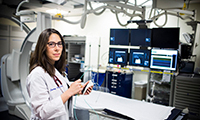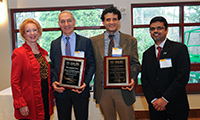What’s one of the biggest hurdles to startup success? Finding enough money to start.
Seed funding is absolutely critical to getting new technologies on the market. It’s the money that can help give an idea a physical shape, put it on the path to becoming a full-fledged product. The POC fund is a simple idea reflected in its simple acronym: proof of concept. The fund is meant to give Emory inventors enough money to develop their product with as little bureaucratic stalling as possible. By getting funds into the hands of innovators quickly and effectively, and by helping provide follow-up funding opportunities, we’ve been able to push the growth of multiple startups. Today, we highlight two teams that have used our POC funding to full effect: CorAmi and Covanos, both focused on finding new ways to treat heart disease.
CorAmi
Scientists have made leaps and bounds in finding new ways to heal our organs when they break. New medicines promise to restore damaged tissues in the heart, intestines, pancreas and beyond by physically attaching regenerative cells or drugs onto them using substances called hydrogels. But how do we get those drugs to hard-to-reach areas – for example, the surface of the heart?

Rebecca Levit, MD
That’s where CorAmi comes in, with a proprietary device designed to deliver these hydrogels and related medications straight to the heart without requiring invasive surgery. Rebecca Levit, MD, is the inventor of this technology and CSO of CorAmi Therapeutics. She came up with the idea for her solution while working as a resident/ research fellow studying regenerative medicine. Levit was well aware of the technical challenges surrounding hydrogels, but was also interested in how to get them there. If a patient happened to need open heart surgery, delivery wouldn’t be a significant concern – but most patients don’t.
The challenge, then, is to create a device that can be inserted into the chest, through the sac that keeps your heart suspended in liquid called the pericardium, and on top of the surface of the damaged heart tissue – all without breaking blood vessels or interrupting the electrical signals that control the heart. After coming up with an initial design, Levit went to the Coulter Foundation and the OTT, who awarded her thirty thousand dollars from the POC fund to develop proof of concept for her device. She used the funding to hire an engineer, and with him created a design that could lay a hydrogel onto the heart without leaking out.
But many hydrogels are still waiting for FDA approval. “It’s like having a gun with no bullets,” Levit says.
So today, CorAmi is soliciting their hydrogel delivery device along with their own medication: a formulation of amiodarone, a drug that can treat irregular beating of the heart. With many hydrogels awaiting approval by the FDA, delivery systems like CorAmi’s could be part of a new frontier in treating patients.
Covanos
About 1 million cardiac catheterizations (or caths) are performed in the United States every year. It’s a common procedure, but only a few steps short of surgery – it involves threading a long tube from outside the body through an artery in the leg and into the coronary arteries that supply blood to the heart. A contrast agent is injected and visualized using X-rays to see whether there are atherosclerotic plaques that are obstructing blood flow. This information is used to decide on further treatment, such as placing stents in the arteries or performing bypass surgery. About 50% of those caths, however, turn up negative results for obstructive coronary artery disease, so there was no need to have the cath procedure. Because of this, there’s a real need for a noninvasive but accurate way of screening for those people who actually should have the cath procedure performed – a need that can be fulfilled using 3D imaging technology and computational fluid dynamics.

Deborah Bruner; Habib Samady & Alessandro Veneziani; Raj Guddneppanavar
Don P. Giddens, PhD is the former dean of the College of Engineering at Georgia Tech and COO of Covanos, Inc., a start-up company that grew out of Emory research. He’s an expert in the fields of fluid dynamics and biomechanics – two fields that find their natural intersection in our circulatory system. Along with Emory cardiologist Habib Samady, MD and mathematics and computer science professor Alessandro Veneziani, PhD, the Covanos team recognized the need for a sea change in the way cardiac diseases were detected and set their interdisciplinary knowledge to the task.
CT scans have been a mainstay of medical imaging since the 1970s. By using X-rays to fire energy beams from many different angles, computers can receive and transform signals into three-dimensional images that doctors can use to diagnose disease. But it takes sensitive equipment and a lot of computing power to generate accurate pictures of spaces the size of the blood vessels in your heart. And images of the arteries alone don’t tell the whole story, and that’s where the fluid dynamics comes in – the images generated by CT scans form models for computing blood flow characteristics with mathematics similar to that used in aerospace engineering. A related technology has been approved by the FDA – but those systems don’t deliver services at the point of care for patients and also require supercomputers. To overcome those hurdles, Covanos optimized the relevant calculations to create a technology that can deliver results to the physician in less than an hour when used by a trained CT technician.
The initial Proof-of-Concept grant the Covanos team received from Emory’s Office of Technology Transfer allowed them to test their central question: can we make those computations faster?
“Our first test,” said Giddens, “was to see if we could simplify [the mathematics] without sacrificing accuracy … and that was successful.”
The information received from the CT scans allows for the calculation of a patient’s BFPi, or blood flow physiology indices – a set of metrics doctors use to determine whether a patient’s blood flow is healthy. Thanks to Covanos’ work, these programs can now “do the calculations in less than an hour on a laptop or desktop computer, by comparison to many hours on a supercomputer.”
Giddens credits the OTT for helping Covanos build important relationships among new partners and for helping to file patents for the technology. Recently, the OTT awarded Covanos its 2018 Deal of the Year Award after Emory entered into a licensing agreement for their software. With further support from the Coulter Foundation and the Georgia Research Alliance, Covanos has since expanded its team of innovators, moving closer to developing a product that could significantly improve the quality of cardiac care.
Read more about Covanos on their website.